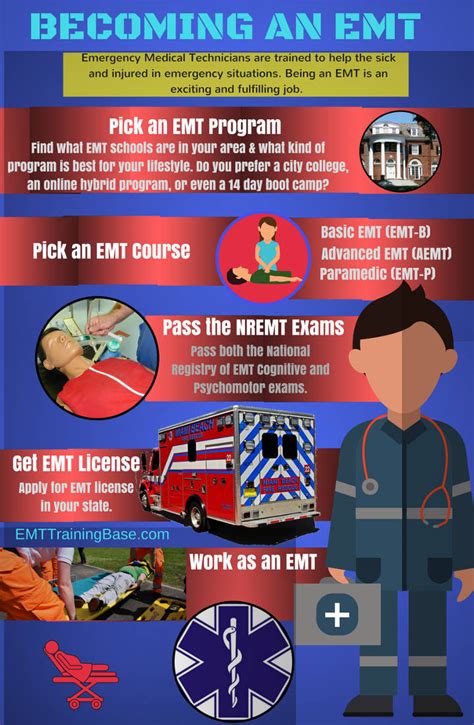How To Become an EMT: A Comprehensive Guide
Becoming an Emergency Medical Technician (EMT) is a rewarding career path for individuals passionate about helping others in critical situations. It's a demanding but fulfilling job requiring dedication, compassion, and a strong commitment to learning. This guide outlines the steps to becoming a certified EMT.
Step 1: Meet the Basic Requirements
Before you even think about classes, ensure you meet the fundamental requirements. These vary slightly by state but generally include:
- Age: Most states require you to be at least 18 years old.
- High School Diploma or GED: A high school diploma or its equivalent is a prerequisite.
- Valid Driver's License: You'll likely need a valid driver's license with a clean driving record, especially for ambulance work.
- Physical and Background Checks: Expect thorough physical and background checks to ensure you're physically and mentally fit for the job and possess the integrity required.
- Clean Criminal Record: Felonies or certain misdemeanors can disqualify you.
Step 2: Choose an EMT Program
Selecting the right EMT program is crucial. Research accredited programs in your area, considering factors like:
- Accreditation: Ensure the program is accredited by a nationally recognized organization like the Commission on Accreditation of Allied Health Education Programs (CAAHEP) or the Committee on Accreditation of Educational Programs for the Emergency Medical Services Professions (CoAEMSP). This ensures a quality education meeting industry standards.
- Program Length and Format: Programs vary in length and format (full-time, part-time, online components). Choose a program that fits your schedule and learning style.
- Clinical Hours: Look for programs offering sufficient hands-on clinical experience. Practical training is vital for EMT work.
- Cost: Consider the overall cost of the program, including tuition fees, books, and supplies.
Step 3: Complete Your EMT Training
The EMT program will cover a wide range of topics including:
- Emergency Medical Response: Learning to effectively respond to emergency calls.
- Patient Assessment: Mastering techniques for quickly and accurately assessing patients' conditions.
- CPR and Basic Life Support: Becoming proficient in CPR and basic life support procedures.
- Trauma Care: Understanding how to manage various types of trauma injuries.
- Medical Emergencies: Learning to handle various medical emergencies, such as heart attacks and strokes.
- Emergency Vehicle Operation: (If applicable) Safe operation of emergency vehicles.
Practical Skills to Master:
- Airway Management: Skills related to maintaining a patient's airway.
- Bandaging and Wound Care: Proper techniques for treating wounds.
- Immobilization: Techniques for securing injured patients.
- Medication Administration: Safe and effective administration of medications.
Step 4: Pass the National Registry Exam
Once you've completed your EMT training, you'll need to pass the National Registry of Emergency Medical Technicians (NREMT) exam. This is a crucial step toward certification. This exam tests your knowledge and skills learned throughout your training.
Step 5: Obtain Your State Certification or Licensure
After passing the NREMT exam, you'll typically need to apply for state certification or licensure. Requirements vary by state, so check your state's requirements.
Step 6: Find Employment Opportunities
With your EMT certification in hand, you can start searching for job opportunities. Potential employment settings include:
- Ambulance Services: Working for private ambulance companies or municipal fire departments.
- Hospitals: Working in emergency rooms or as part of hospital-based transport teams.
- EMS Agencies: Working for county or state EMS agencies.
Continuing Education for EMTs
The field of emergency medical services is constantly evolving. Continuing education is crucial to stay updated on the latest techniques and protocols.
This comprehensive guide provides a strong foundation for anyone interested in becoming an EMT. Remember to thoroughly research programs in your area and diligently prepare for the NREMT exam. A career as an EMT is demanding but incredibly rewarding, offering the chance to make a real difference in people's lives.
